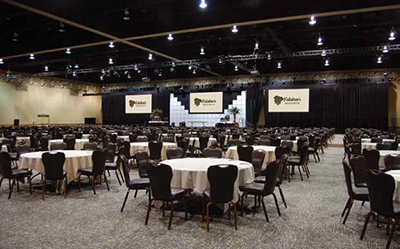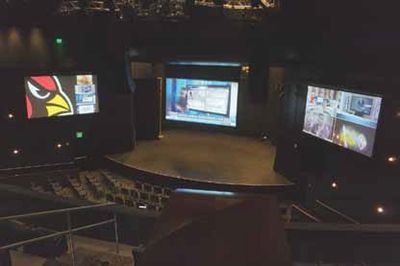Unlock the Continuing Profit in Active System Upgrades

The newly expanded Kalahari Resort Convention Center in Ohio recently completed a $22 million expansion that includes a 38,000-square-foot grand ballroom/expo center, a 12,000-square-foot junior ballroom, 14 meeting rooms, and 30,000 square feet of pre-function space. The resort relies on Crestron DigitalMedia for digital AV distribution throughout the
facility.Nothing lasts forever, not even an AV system. Despite its melodious sound, obsolescence signifies the finale, outta here.
But rather than marking the end of the line for a system, obsolescence can usher in a new round in the ever-upgrading AV cycle, furthering the contractor/client relationship.
As the AV system lifespan shrinks with the rapid progression of technological innovation, the AV business model will adopt IT attributes if it wants to survive, suggested Bob Sharp, director of sales engineering at SVSi. “The IT integrator understands low margins on hardware that by and large is commoditized and achieves profitability though managed services offerings.”
Having seen the AV industry adopt IT attributes already, Crestron has grown to support these new demands on AV, explained Michael DiBella, marketing solutions manager for the manufacturer. “Our customers are no longer thinking of their AV systems in terms of a single room or as something separate from the network. Because of this, we have developed an AV DM solution that is enterprise wide and can be monitored, managed, and controlled over a single IP address.”
Not So Fast
But a radical AV evolution is difficult to predict in the short run, and apart from some elaborated matrices with interchangeable cards, only a few products allow real adaptation to a changing technological environment, noted Franck Facon, marketing and communications director for Analog Way. “In the processing industry, hardware remains the basis in AV business, and it keeps on evolving to match the new norms and standards.”
Over the last 20 years, the product life cycle for the processing industry was reduced by half. Now it’s about three years due to the fast evolution of pro AV technologies, he said, with obsolescence highlighting the dynamism of the market, stimulated mainly by competition and innovation.
A daily selection of the top stories for AV integrators, resellers and consultants. Sign up below.
Bill Schripsema, commercial product manager at Atlona, is not convinced that the lifespans of AV systems are shrinking since their lifecycles rarely have been longer than they are today.
“Customers have never received more bang for their buck,” he said. “Projectors last longer than ever before, LCD displays are more durable, and costs are a fraction of what they used to be for identical performance. In addition, some recent technical innovations haven’t taken root. For instance, 3D technology hasn’t changed the game as some had predicted.”
In terms of audio, systems have been amazingly consistent, Schripsema noted. “Upgrades aren’t needed as frequently, although line array speaker design and DSP electronics have increased power while decreasing cost and size. Old systems can still perform very adequately.”
Updates and innovation have always been part of the industry. Examples include the evolution of screens from light valve and CRTs to plasma displays and LCD flat panels.
“Computer sources also began with custom adaptors such as 5x BNC, CGA or EGA, and VGA, until HDMI connectors came to the marketplace 15 years later,” Schripsema pointed out. “Other examples are sources that started at 0.75-inch U-Matic, and then went to Beta, VHS, and DVD before the Blu-rays of today.”
A well-designed AV system can still be very functional without the latest or greatest hardware, he contended. “Probably, the most significant upgrade today is the drive to implement digital signal inputs and outputs. Instead of undertaking a complete system update, installers can simply use convertors and digitizers. A second area for updates is wider aspect ratio and higher resolution displays. If the life of a projector is seven years, then it would be more appropriate to also change the switching and other infrastructure at the same time.”
A Change is Coming
As sales, service, and maintenance processes change in the era of upgrades, Sharp said, “developing a meaningful and profitable managed services component to any installation will be the norm.”

The Wharton School of the University of Pennsylvania applied IT practices to their AV approach. Crestron DigitalMedia was installed to work with RoomView to manage, control, and distribute all analog and uncompressed HD digital content.Yet because of market size, the economic model may be difficult to set up because, contrary to the IT market, the AV market is spread out with a quantity of companies composing the product offer. “Services might be hard to organize due to a lack of important and regular revenues,” Facon said. “Sales forces are not always formed to sell services. In addition, the AV business relies on a market in which the availability of some of the technology installed is not crucial for the functioning of companies.”
The necessity for maintenance and services needs to be embedded in a customer’s understanding of the ongoing process. “The AV solutions first have to become a real must for them, so that customers feel the real need for services and maintenance for their AV installations,” he said.
Smart designers anticipate future needs during the original design so that a system is leading edge when installed, adequate during the middle years, and still functional toward the end of its lifespan.
“If a customer decides to install a system that is only adequate at the time of installation, it may need to be replaced sooner as technology changes may render it unusable toward the end of its life,” Schripsema said. “Customers should understand those choices during the sales process.”
Seven-Year Itch

No new cable was run for an upgrade to the showroom at the Talking Stick Resort in Scottsdale, AZ. Content for screening NFL games to three projectors is delivered and switched to the desired screen over the house data network from the AV room using SVSi technology.Expect to replace the whole system after seven years, Schripsema noted. “It may not be obsolete, but there is a good chance that it will no longer be reliable. The most difficult thing to change is the cable in the walls, so always pull extra cables and fiber to make upgrades easier.”
Facon believes the ideal platform should be oversized, but this implies higher costs in production, sale, and upgrade. “The numerous evolutions in norms and standards make the process hazardous,” he said, “and I’m not sure customers are ready to buy for durability without guarantees. For a systems integrator, setting up such an infrastructure might be tricky because the choices made have to be winning in the long term.”
Uncertainties in electronic components production, technological evolutions, and manufacturers’ motivations are important. “The software participates in the components’ obsolescence,” Facon said. “In brief, designing, producing, maintaining, and supporting a range or product evolution is possible for two generations, but beyond this limit, it’s quite complicated.”
Because of the way Crestron has engineered and designed product, its technology is based on expansion, DiBella said. “Our infrastructure is already on an existing single managed platform. There always comes a time for a complete upgrade, but it is not always necessary. We know that for integrators, time is money, and we take that to heart in our end-to-end solutions, so they can expand the systems room-to-room or campus wide.”
Remember that ethernet and IP technology have evolved and expanded over the past 40 years while retaining an almost perfect record for both backward and forward compatibility, Sharp concluded. “Merging AV systems on to this platform will assure expandability rather than replacement.”
Karen Mitchell is a freelance writer living in Boulder, CO.
Broaching the Subject
With technology growing and expanding at a rapid pace, it’s essential that integrators solidify their ongoing client relationships by introducing the obsolescence/upgrade topic early on, and by assuring clients that they will be afforded considered updates as systems age.
“As we integrate more new forms of technology into commercial AV distribution environments, such as smartphones, tablets, and other wireless devices, it is imperative that integrators continually consult with their customers to ensure that they have an infrastructure they can support and integrate with these new sources of content and communication,” said Crestron’s Michael DiBella.
Have this discussion early in the process relative to the customer’s expectations for the life of the system, advised Atlona’s Bill Schripsema. “Educate them on the costs for designing future needs and extending the life of the system. Constant changes are going to be the exception. In an integrated system, it can be very challenging to change even a small item since everything is designed to work together.”
It will be hard for integrators to propose a durable solution based on the choice of one manufacturer; this idea would rely on a system with predictable technological evolution, and customers sticking to their requirements, which is not realistic, said Analog Way’s Franck Facon. “The changing needs, technological evolutions, and appeal of innovation are realities that should reassure clients in the choice of great solutions despite their inevitable obsolescence. Environmental impact also is a factor; the idea of an ever-upgrading system is an appealing one from an eco-friendly perspective.”
Disregard the notion that a sale should be considered as all said and done, added SVSi’s Bob Sharp. “Regardless of the technology, the integrator should provide a value-add proposition such as expandability without obsolescence as an integral part of the design. And be positive. Assume that your client’s AV requirements will increase as their business grows.”
—K.M.
